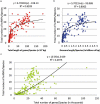Transcriptome protection by the expanded family of hnRNPs
- PMID: 30596342
- PMCID: PMC6380323
- DOI: 10.1080/15476286.2018.1564617
Transcriptome protection by the expanded family of hnRNPs
Abstract
The family of heterogeneous ribonucleoproteins (hnRNPs) have multiple functions in RNA metabolism. In recent years, several hnRNPs have also been shown to be essential for the maintenance of transcriptome integrity, by preventing intronic cryptic splicing signals from mis-splicing of many endogeneous pre-mRNA transcripts. Here we discuss the possibility for a general role of this family of proteins and their expansion in transcriptome protection.
Keywords: Hnrnps; cryptic splicing; introns; transcriptome integrity.
Figures


Similar articles
-
Functional diversity of the hnRNPs: past, present and perspectives.Biochem J. 2010 Sep 15;430(3):379-92. doi: 10.1042/BJ20100396. Biochem J. 2010. PMID: 20795951 Review.
-
Rbm3 deficiency leads to transcriptome-wide splicing alterations.RNA Biol. 2024 Jan;21(1):1-13. doi: 10.1080/15476286.2024.2413820. Epub 2024 Oct 10. RNA Biol. 2024. PMID: 39387568 Free PMC article.
-
RNA-binding protein hnRNPLL regulates mRNA splicing and stability during B-cell to plasma-cell differentiation.Proc Natl Acad Sci U S A. 2015 Apr 14;112(15):E1888-97. doi: 10.1073/pnas.1422490112. Epub 2015 Mar 30. Proc Natl Acad Sci U S A. 2015. PMID: 25825742 Free PMC article.
-
αCP binding to a cytosine-rich subset of polypyrimidine tracts drives a novel pathway of cassette exon splicing in the mammalian transcriptome.Nucleic Acids Res. 2016 Mar 18;44(5):2283-97. doi: 10.1093/nar/gkw088. Epub 2016 Feb 20. Nucleic Acids Res. 2016. PMID: 26896798 Free PMC article.
-
Research Progress on the Structural and Functional Roles of hnRNPs in Muscle Development.Biomolecules. 2023 Sep 22;13(10):1434. doi: 10.3390/biom13101434. Biomolecules. 2023. PMID: 37892116 Free PMC article. Review.
Cited by
-
The hnRNPK/A1/R/U Complex Regulates Gene Transcription and Translation and is a Favorable Prognostic Biomarker for Human Colorectal Adenocarcinoma.Front Oncol. 2022 Jul 7;12:845931. doi: 10.3389/fonc.2022.845931. eCollection 2022. Front Oncol. 2022. PMID: 35875075 Free PMC article.
-
Long non-coding RNA lincRNA-erythroid prosurvival (EPS) alleviates cerebral ischemia/reperfusion injury by maintaining high-temperature requirement protein A1 (Htra1) stability through recruiting heterogeneous nuclear ribonucleoprotein L (HNRNPL).Bioengineered. 2022 May;13(5):12248-12260. doi: 10.1080/21655979.2022.2074738. Bioengineered. 2022. PMID: 35549989 Free PMC article.
-
HNRNPK/CLCN3 axis facilitates the progression of LUAD through CAF-tumor interaction.Int J Biol Sci. 2022 Oct 17;18(16):6084-6101. doi: 10.7150/ijbs.76083. eCollection 2022. Int J Biol Sci. 2022. PMID: 36439880 Free PMC article.
-
Genome-wide evolution of wobble base-pairing nucleotides of branchpoint motifs with increasing organismal complexity.RNA Biol. 2020 Mar;17(3):311-324. doi: 10.1080/15476286.2019.1697548. Epub 2019 Dec 19. RNA Biol. 2020. PMID: 31814500 Free PMC article.
-
Role of TNF-α-induced m6A RNA methylation in diseases: a comprehensive review.Front Cell Dev Biol. 2023 Jul 24;11:1166308. doi: 10.3389/fcell.2023.1166308. eCollection 2023. Front Cell Dev Biol. 2023. PMID: 37554306 Free PMC article. Review.
References
-
- Schwartz H, Darnell JE.. The association of protein with the polyadenylic acid of HeLa cell messenger RNA: evidence for a “transport” role of a 75,000 molecular weight polypeptide. J Mol Biol. 1976;104:833–851. - PubMed
-
- Pinol-Roma S, Choi YD, Matunis MJ, et al. Immunopurification of heterogeneous nuclear ribonucleoprotein particles reveals an assortment of RNA-binding proteins. Genes Dev. 1988;2:215–227. - PubMed
-
- Krawczak M, Reiss J, Cooper DN. The mutational spectrum of single base-pair substitutions in mRNA splice junctions of human genes: causes and consequences. Hum Genet. 1992;90:41–54. - PubMed
-
- Lopez-Bigas N, Audit B, Ouzounis C, et al. Are splicing mutations the most frequent cause of hereditary disease? Febs Lett. 2005;579:1900–1903. - PubMed
Publication types
MeSH terms
Substances
LinkOut - more resources
Full Text Sources
